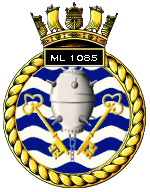SML 4
Following the cessation of hostilities in Europe the Royal Navy found itself in possession of a large quantity of both small vessels and large, for which it now had no immediate purpose for. Whilst the many larger ships, such as the now more obsolete and expensive to run battleships were scrapped.
The small ships in the coastal forces squadrons would prove useful for many roles, ML 1085 was chosen to become a Survey Motor Launch, and as such was re designated SML 4 and based in Portsmouth, after a short spell running from Poole. Although based in Portsmouth, SML4 surveyed the Thames area, and was also at Bremerhaven during 1945 where she surveyed the Weser Estuary and its approaches to Bremen.
She conducted these surveys as a Motor Launch for HMS Franklin, who as a purpose built Survey ship of 1938 and a veteran of DDay herself, and the subsequent surveying needed for the Mulberry harbours at Arromanche, she was well worked up to she co-ordinate the tasking in the Wesser Estuary, but unable to get close in to the shoreline, the HDML’s filled this role well.
For this short notice role the ships had little more than their main guns and depth charges removed, with a quick lick of paint to change colour from warship grey to the then survey colours of white overall.
However this was quickly changed to a black hull as the side exhausts from the Gardner Diesels made quite a mess of this shiny new livery, some retained these colours post war quite well, and largely shearwater did until her days on Loch Etive where she operated with an orange superstructure! After moving to the Small Isles she was repainted with a white superstructure after a little modification, and given a dark blue hull and red Gunwales. Her black hull was changed to blue and her gunwales were painted red, she remained in this colour scheme until her hull was painted green in 2015.
SML 324
The first of the HDML’s proved themselves in the survey tasks they had performed at short notice, subsequently with much more seabed to re chart post war, the navy fitted them out slightly better and redesignated them again. The main differences between wartime HDML’s and the later survey variant is the lack of main armament and depth charges, also the later ones were refitted with a hydraulic capstan. Internally their chart rooms were adapted and more advanced sonars followed from the DDay channel location sounders.
SML4 was deployed to Ostende in 1946 becoming SML 324. As SML 324 was attached to larger vessels aswel as operating alone between Apr 1951 and May 1952, she was attached to HMS Scott, another Halycon class survey ship, sister to HMS Franklyn and the ship she relieved surveying for the Mulbery harbours post DDay.
|
SML 324 then conducted further surveys along the East Coast before returning to act as a tender for the survey ships based at Chatham in 1954, again performing the close in work the larger ships could not manage, then two years later she was on the move again, to Harwich this time, where for two years she took part in surveying the East Coast again, she was then placed on reserve in 1958.
|
At this time her active Naval service came to an end when she was handed over to W. C. Allan & Son at Gillingham in Kent, on a care and maintenance basis and was advertised for sale.
